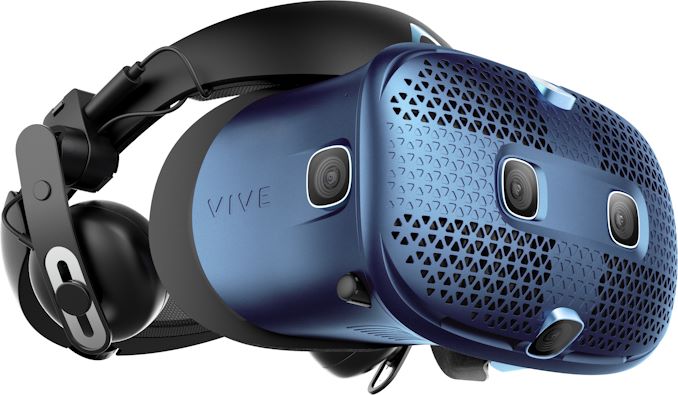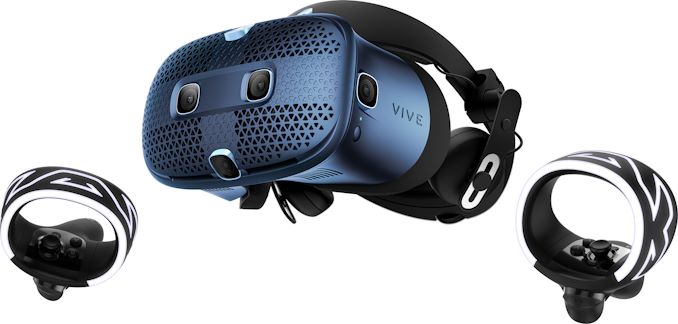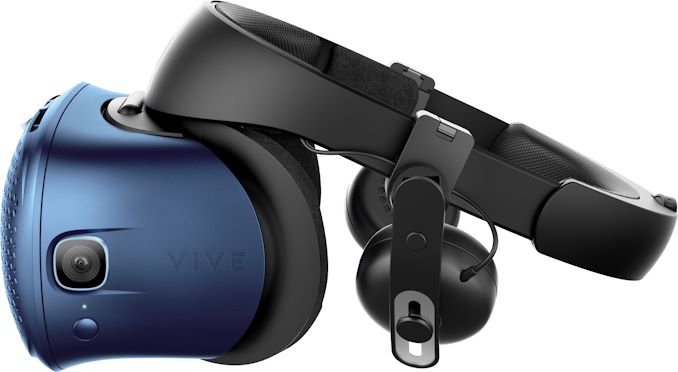HTC Unveils Final Specs & Availability Date of Cosmos VR Headset for PCs
by Anton Shilov on September 13, 2019 11:00 AM EST- Posted in
- VR
- HTC
- Vive
- Vive Cosmos

HTC this week announced final specifications as well as availability date of the Vive Cosmos, its next-generation tethered VR headset, which promises numerous improvements along with modularity for further upgrades. Among the key features of the Vive Cosmos are higher resolution displays, full 6DoF inside-out tracking built around six cameras and integrated sensors, a lower weight, as well as all-new knuckles-style controllers. The headset is available for pre-order now and will ship in early October.
Originally unveiled at CES early this year, the Vive Cosmos head mounted display (HMD) is equipped with two 3.4-inch RGB LCD screens, each offering a per eye resolution of 1440×1700 (2880×1700 combined resolution), a 90 Hz refresh rate, and a 110-degree field of view (officially, this is the same as the original Vive). On which note, HTC has been relatively mum on the optics used, though it has been confirmed that they're continuing to use Fresnel lenses.
As this is a tethered headset by default, in its standard configuration the HMD connects to a host PC using via DisplayPort 1.2 and USB 3.0. Alternatively, the VR HMD can be equipped with a WiGig-based wireless adapter from HTC.
The VR headset comes with a built-in inside-out 6-degree-of-freedom (6DoF) positional tracking enabled by six cameras, a G-sensor, as well as a gyroscope, which is an important distinction from the original Vive (and Vive Pro), as it does not require any external sensors for tracking. This greatly simplifies the setup process and removes some of the friction from using the device, though as a realistic assessment it's unlikely to be quite as stable as using external sensors. Like all HTC Vive HMDs, the Cosmos has its own spatial audio-supporting stereo headphones as well as microphones.
The new headset also comes with brand-new knuckle-style controllers, which are tracked by the HMD as part of its inside-out tracking. The controllers feature touch sensitivity, two application buttons, a trigger, a joystick, a bumper, and a grip button; all the common controls found on current-generation VR controllers. There is one notable caveat about the Cosmos controllers though: they are powered by two AA batteries and cannot be recharged from outside, which means that users will need to swap batteries after they get run down.
A unique capability of the Vive Cosmos is modular design of its front panel, which can be detached and replaced by another one, allowing upgrades and new features to be added. Fittingly, the very first ‘mod’ is the Vive Cosmos External Tracking Mod, and it is designed to allow the headset to be tracked externally using the SteamVR ecosystem's existing Lighthouse base stations (though this also means the Cosmos controllers cannot be used). This one will be available in Q1 2020 for under $200.
The new HTC Vive Cosmos has a lower weight compared to its predecessors, the manufacturer says without elaborating. Meanwhile, the HMD continues to use a headstrap similar to that of the Vive Pro, with a sizing dial and enhanced ergonomics that balance the weight for added comfort.
HTC’s Vive Cosmos VR headset will be launching on October 3rd for $699. However for anyone looking to get started right away, HTC has already started taking pre-orders this week.
Related Reading:
- HTC at CES 2018: Vive Pro VR Headset with Higher-Res Displays, Two Cams, Headphones
- Valve Index VR Headset: 1440×1600 per Eye and 120/144 Hz LCDs
- HP Reverb Virtual Reality Headset: A 4K HMD with 6DOF
- Oculus Rift S VR Headset: An Upgraded Virtual Reality Experience
Source: HTC













32 Comments
View All Comments
Beaver M. - Tuesday, September 17, 2019 - link
Problem is that most OLEDs still have massive motion blur. I still remember CRT "motion blur". It was a night and day difference to LCDs. But most OLEDs act exactly the same way as LCDs in that aspect, because they havent been built to get rid of motion blur. Its a feature even OLEDs have to have, (which I cant recall the term for right now) and most simply dont offer it.Why wouldnt you recommend an OLED as a bar TV? People there wouldnt care much about the picture quality anyway. Nor would you really notice it from as far away as you normally sit from bar TVs. I would very much recommend it as a bar TV, because it saves power.
I wouldnt recommend it to people who use it to play console games.
Beaver M. - Tuesday, September 17, 2019 - link
But this wouldnt be the case if there were videos cards supporting this properly, because then panels like this would be cheaper, since more people would want one.Skeptical123 - Sunday, September 15, 2019 - link
There are manufacturing limitations and basic common sense that no computer on the planet could render games close to two 4k feeds at 120HZ in 2019 till at least ~2022. The big point I have not seen anyone mention is the fact that these basics stats mean very little. As usual there are other factors at play that matter a lot more. For VR headsets the screen HZ is effective a myth as the early Oculus team discovered and shared with the industry around 2013 if memory serves me. Yes of course you want more than 60fps but after ~75fps it does not matter much as the main factor is the pixcel response time in the sense of black to black. They pinned that down as the main cause of motion sickness. So the short version is a screen resolution is "set" around 2k due to production of the screen and the required computer resources to drive it. And a stable frame rate above 60 only matters if the other specs of the panned meet the special needs of VR. "4k oled@120" is used more by marketers than engineers for a reason...nandnandnand - Monday, September 16, 2019 - link
No.https://www.blurbusters.com/blur-busters-law-amazi...
We should be looking to hit at least 240 Hz, if not 1000 Hz.
Resolution should top out at 16K (or ~132 megapixels) over a wide field of view (200-220° horizontal, 150-180° vertical).
Foveated rendering can massively reduce the GPU requirements, possibly by over 95%. The VR headset is obviously a good place for eye tracking, but maybe gaming monitors could also use it. Add in depth sensing to determine how far away the eyes are from the display.
Santoval - Monday, September 16, 2019 - link
"Resolution should top out at 16K (or ~132 megapixels) over a wide field of view (200-220° horizontal, 150-180° vertical)."I assume, since you are quoting FOV degrees, that you are referring to VR panels. A 16K resolution for a tiny 3 - 4" panel is almost certainly never going to happen*. The pixel density is just immensely high, and adding a very high refresh rate on top of that is a further technical hurdle.
*At least not with LCDs, OLEDs and every other display technology that's currently widely available. MicroLEDs could apparently do it. The tiny microLED display described in the link has 14,000 PPI, or ~17 times the pixel density of the current record holder smartphone, Sony Xperia XZ Premium, which has 807 PPI.
I did a quick calculation with an online tool and found that with 14,000 PPI you can reach a 16K resolution at just 1.25", so there is plenty of room to spare. That microdisplay is amazingly even denser than the original target I thought was beyond reach :
https://venturebeat.com/2019/05/30/mojo-vision-rev...
Driving such a VR headset with a powerful enough PC and graphics card would be another matter though..
nandnandnand - Monday, September 16, 2019 - link
The FOV I'm describing would require 2 panels, or maybe 1 large flexible one.StarVR One has 210°h/130°v FOVs and 2x 4.77-inch panels with a 22.5:9 total aspect ratio.
For my endgame headset, I'm looking for 220°h/(150-180)°v FOVs. PPI should end up somewhere between 2000 and 4000.
Here's 2,228 PPI AMOLED: https://www.roadtovr.com/int-announces-2228ppi-hig...
What I'm describing is very achievable. As for driving it, add eye tracking and use foveated rendering. As an example, if you render 1% of the display at 16K at any given moment, 1% at 8K, 1% at 4K, 1% at 1080p, and 96% at 720p, that's just 2,647,296 pixels out of 132.7 megapixels, the equivalent of 2% of 16K or just 127% of 1080p. You can play around with the %s but you get the idea.
p1esk - Monday, September 16, 2019 - link
I've seen benchmarks that showed 120Hz+ for 4k gaming (I think it was Shadow of Tomb Rider) on two 2080Ti in SLI. So yes, you can drive two 4k@120Hz feeds in 2019 if you have four cards.Beaver M. - Tuesday, September 17, 2019 - link
But the video card limitation is the main reason.There simply arent videocards that can support something like this properly. VR games already have to have inferior graphics to normal games to be able to work fine.
Blame Nvidia and AMD for not getting their hooves out of their mouths.
Imnstead they actually release cards that are only slightly faster than the last generation, offers less or as much VRAM only and costs MUCH MUCH more than the last generation.
So it might still take quite a while until we see displays in VR headsets that dont show screen door effects.
nandnandnand - Friday, September 13, 2019 - link
The field of view is also garbage.glnpwl - Monday, September 16, 2019 - link
Its not, its 90hz which is the standard for VR Headsets. The only headset to fall below this is Rift S, and the only one so far that has surpassed it is the Valve Index offering 122hz. Both Cosmos and Index offer something different in my opinion, with Index you get the wider FOV and higher framerate, but with Cosmos, you get options between insideout tracking and external base stations to track you plus passthrough that is in color, higher resolution than the Vive Pro, and built-in headphones instead of off ear speakers. Also, Cosmos price point for 2 controllers and a headset is a few hundred cheaper than for a valve index and index controllers.